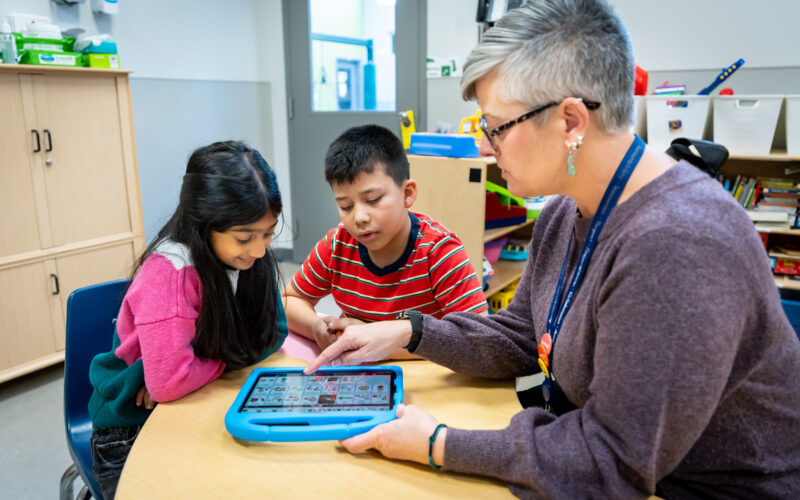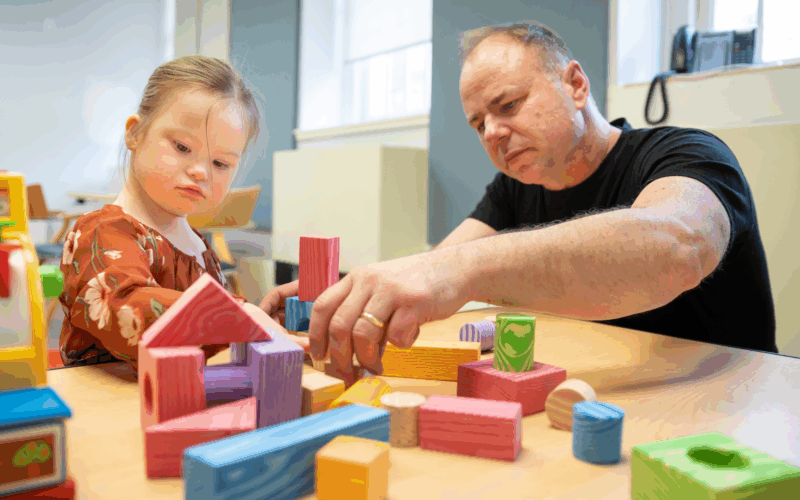Table of contents:
- What is a Welcome Letter (Service Plan)?
- A Family’s Experience
- What Might a Service Plan Include?
- What’s Not Included in a Service Plan?
- Need Help Getting Started? Visit a Drop-In Day
- Service Coordination: Navigating the System
- The Road Ahead: Growing with Your Service Plan
Receiving your child’s autism diagnosis is a turning point.
In our last article, Starting from the Beginning – What Do I Do After My Child’s Autism Diagnosis?, we walked through assessments and those first steps into the world of autism services in Ontario.
The next question many families ask is: ‘What happens now?’
That’s where the Welcome Letter, also called a Service Plan, comes in.
What is a Welcome Letter (Service Plan)?
After the intake and assessment process, every child, teen, or adult who connects with Surrey Place receives a personalized Welcome Letter (Service Plan).
This 1–2-page document is:
- Personalized: based on your loved one’s needs and your family’s goals.
- Practical: a summary of recommended programs and supports.
- Action-oriented: designed to help you move from assessment to services.
You’ll also receive a Surrey Place ID (SPID) number. This unique identifier keeps all your information in one place, making service navigation easier as you access programs over time.
Think of the Welcome Letter (Service Plan) as your roadmap — something to return to when making decisions, applying for funding, or planning the next step in your autism journey.
A Service Plan is more than a list. It’s a roadmap that gives families a clear starting point and connects them to the right supports.
– Natalie Healy, Manager, Intake, Cross Agency Clinical Services, Coordinated Service Planning
A Family’s Experience
For many families, receiving a Service Plan brings a sense of relief. After the diagnosis, it’s common to feel overwhelmed by new terms, waitlists, and uncertainty about where to begin. The Service Plan helps cut through that confusion by showing families which therapies make the most sense right now, what to do while waiting, and who to contact with questions.
Families often share that this is the first time they feel like they have a clear path forward. While the Service Plan doesn’t remove every challenge, it provides direction, reassurance, and a practical place to star.
What Might a Service Plan Include?
Because every person is unique, no two Service Plans are the same. Each one highlights only the recommendations that fit your child, teen, or adult family member’s needs.
Here are some examples of what might be included:
For young children (under age 6):
- Early intervention programs like speech and language therapy or occupational therapy.
- Parent training programs to support communication and play at home.
- Developmental consultation in natural settings, such as your home.
- Connections to EarlyON centres and community supports.
For children with challenging behaviours (sometimes called “big feelings”):
- Parent coaching to learn calming and co-regulation strategies.
- Applied Behaviour Analysis (ABA) to support communication, daily routines, and self-regulation.
- Social skills groups to encourage peer interaction.
For teens:
- Social and recreational opportunities to connect with peers.
- Resources from our Resource Library that support transition planning, and offer guidance for parents and caregivers on topics such as having meaningful conversations about gender and sexuality.
- Referrals to mental health services, if needed.
For adults
- Skill-building programs such as cooking, money management, or self-care.
- Transition planning for school, employment, or adult services.
- Service coordination to link with programs across different sectors.
Family Tip: It’s normal to feel like you need to start every program at once. But small steps go a long way. Begin with one or two services from your plan, and give your family time to adjust before adding more.
What’s Not Included in a Service Plan?
Families sometimes ask if the Service Plan will include paid program options. Typically, these are not listed. The Welcome Letter focuses on the most relevant recommendations and supports for your child’s needs, including community programs and services offered at no cost.
That said, we know many families, especially those registered with the Ontario Autism Program (OAP), are also interested in exploring paid options. While these are not part of the Service Plan itself, Surrey Place can still help you learn about them.
Once your intake is complete, a Service Coordinator will connect with you to gather more information about your child and family goals. From there, you’ll receive a summary of personalized recommendations for paid services and programs that best fit your needs.
You can also attend Discover Your ABA Journey, an in-person event where parents and caregivers can learn about paid ABA services, ask questions, and receive guidance on which programs may be the best fit.
Together, these supports help families make informed choices about both funded and paid options, while your Service Plan continues to guide your path through community programs and wellness supports.
Need Help Getting Started? Visit a Drop-In Day
Families don’t have to navigate services alone. Our Intake Team is available on-site daily at our downtown location (2 Surrey Place) and weekly at our other sites in Etobicoke, North York and Scarborough to answer questions, guide registration, and help you understand your next steps.
Our drop-in days are informal opportunities to stop by without an appointment, talk directly with intake staff, and get help with:
- Exploring paid and funded program options
- Registering for services
- Accessing community resources
Whether you’re just getting started or updating your plan, these in-person sessions make it easier to get answers, connect with the right supports, and feel confident about your next steps.
Beyond Drop-In Days, families can also count on ongoing support through our Service Coordination team.
Service Coordination: Navigating the System
Your Service Plan is just the beginning. From there, Surrey Place’s Service Coordinators are by your side to:
- Explain recommendations and answer questions.
- Connect you with wellness offerings such as workshops, caregiver coaching, and resource clinics.
- Update your plan as your child grows and needs change.
Service Coordinators make the system feel manageable. Families know they have someone to turn to at every stage.
– Natalie Healy, Manager, Intake, Cross Agency Clinical Services, Coordinated Service Planning
This ongoing support ensures you don’t have to navigate Ontario’s autism services alone.
The Road Ahead: Growing with Your Service Plan
Your Welcome Letter (Service Plan) is a starting point, not a final document. As your child, teen, or adult family member grows, their needs and goals will change. Families often find it helpful to:
- Share the Service Plan with schools, doctors, or daycares.
- Keep a copy handy for check-ins and funding applications.
- Use it as a guide to register for wellness services and workshops.
With this personalized roadmap, you can move forward with confidence, knowing you have clear next steps and a trusted partner in Surrey Place.


